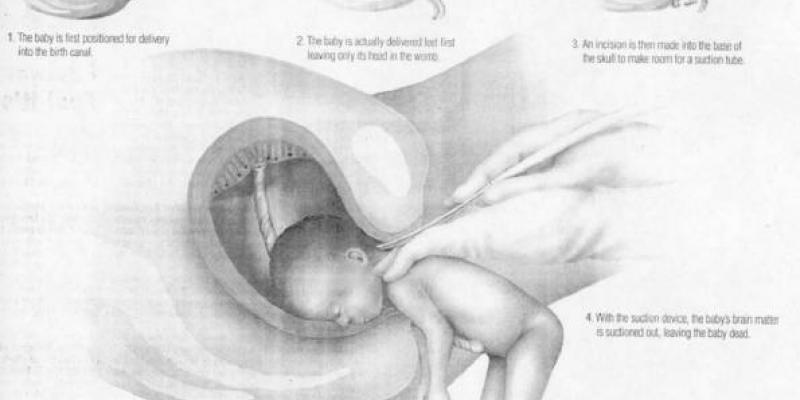PBA203Y: Medical Dilemmas
FIX ME abortion as self-defence? https://blog.equalrightsinstitute.com/refuting-abortion-as-self-defense/
Guiding Principles: How Many Patients?
The guiding principle, recognizing the human rights of the pre-born, is not that either the life/rights of the child or mother takes precedence over the other, but that we’re dealing with two patients in any complication surrounding pregnancy and we need to do our best to attend to the well-being of both.
Is Abortion Ever Ethically Permissible?
-
Killing an innocent human being is never OK – even if it’s to save another human being
-
Example: if one 5 year old needs a heart transplant, we can’t kill another healthy 5 year old to take that child’s organ
-
But that doesn’t mean we do nothing
-
Stephanie Gray analogy: we’re driving and trying to get safely to our destination. One route involves driving over and killing an innocent person, so that particular route is blocked off to us – but there are other routes that get us to the same destination, may just be longer/more complicated
-
-
Is Abortion Ever Medically Necessary?
What do abortionists say?
Dublin Declaration
“As experienced practitioners and researchers in obstetrics and gynaecology, we affirm that direct abortion – the purposeful destruction of the unborn child – is not medically necessary to save the life of a woman. We uphold that there is a fundamental difference between abortion, and necessary medical treatments that are carried out to save the life of the mother, even if such treatment results in the loss of life of her unborn child. We confirm that the prohibition of abortion does not affect, in any way, the availability of optimal care to pregnant women.”
Double-Effect Reasoning & Examples
Performing an act with 2 morally significant effects is justified if 1) the evil effect is not intended as a means or an end, and 2) there is a proportionately serious reason for allowing the evil effect.
Or, to put it differently, 4 principles:
-
Can’t do evil (the action taken must be good or morally neutral)
-
Can’t intend evil (the evil effect must not be intended)
-
Can’t depend on evil (the evil effect must not be the means through which the good comes about – the ends doesn’t justify the means, we cannot do evil so that good may come about.)
-
FIX ME Blaise: Could we add another step? E.g. with salpingectomy: if, in the future, we can care for an embryo or fetus that young, then the baby could be transferred (to an artificial womb or whatever). But with salpingostomy or methotrexate, she will always be dead because we killed her
-
-
There needs to be a really good (proportionate) reason to tolerate evil as an unintended but foreseen side-effect
Examples
Summary of Interventions
The Ethical and Religious Directives established in the United States for Catholic Health Care Services provides thoughtful guidelines that respect both lives (not because they’re Catholic, but because they’re pro-life):
47. Operations, treatments, and medications that have as their direct purpose the cure of a proportionately serious pathological condition of a pregnant woman are permitted when they cannot be safely postponed until the unborn child is viable, even if they will result in the death of the unborn child.
49. For a proportionate reason, labor may be induced after the fetus is viable.”
Ectopic Pregnancy
-
-
Methotrexate stops the growth of rapidly dividing cells, including embryonic cells, and thereby kills the embryo
-
Unethical: intentionally targeting + killing baby
-
-
-
Salpingectomy vs. Salpingotomy
-
Salpingectomy refers to the surgical removal of a Fallopian tube.
-
Ethical because intention is to target pathology, not baby (could hypothetically add a step to save baby, in future, e.g. with an artificial womb)
-
-
Salpingectomy is different from and predates both salpingostomy and salpingotomy. The latter two terms are often used interchangeably and refer to creating an opening into the tube (e.g. to remove an ectopic pregnancy), but the tube itself is not removed
-
Salpingotomy/ostomy: Unethical: directly and intentionally killing the baby
-
-
“But what’s the difference?” Comparing different interventions
Imagine that you are rowing on a lake, and you see two people drowning. You want to save both, but you only have the time or the strength to rescue one person–and while you are doing that, the other person drowns. Were you responsible for the second person’s death? Certainly not–you just weren’t able to save them.
Now imagine that you are in the same scenario, where two people are again drowning. You pull the first person out of the water–but then you push the second person’s head under water. This time, we you responsible for the second person’s death? Yes, you were.
In both cases, the second person dies. But morally, we recognize that there is a difference between not being able to save someone, and intentionally killing them.

(Uterine) Cancer
-
Chemotherapy
Preeclampsia
-
A disorder of pregnancy characterized by the onset of high blood pressure and often a significant amount of protein in the urine.
-
The condition begins after 20 weeks of pregnancy.
-
In severe disease there may be red blood cell breakdown, a low blood platelet count, impaired liver function, kidney dysfunction, swelling, shortness of breath due to fluid in the lungs, or visual disturbances.
-
Pre-eclampsia increases the risk of poor outcomes for both the mother and the baby.
-
If left untreated, it may result in seizures at which point it is known as eclampsia.
-
FIX ME ex. Sybil in Downton Abbey
-
-
Close monitoring is needed
-
Labor induced early labor if needed
-
(Difference between inducing labor to prevent keeping baby and mom in a serious risky situation and inducing labor just because–> Terminal diagnosis, inducing labor)
For example, while a blood test was taken when Savita first arrived at the hospital which showed an elevated white blood cell account, this information was not recorded on her chart.
Further, her vitals were not checked every 4 hours, and several clear signs of sepsis were missed.
All of these discoveries that I’m mentioning were found in the investigative reports by the Health Information and Quality Authority, and the Health Service Executive, as well as the Coroner’s Court inquest into Savita’s death.
Ultimately, what can be learned from this tragic story is that it is possible that an ethical course of action was necessary to treat Savita’s septicemia – to treat her bloodstream infection. But in neither case was abortion the answer. Abortion doesn’t cure septicemia. Abortion doesn’t kill E. coli bacteria. All abortion does is kill a pre-born child. It’s very much possible that it would have been necessary to end Savita’s pregnancy and remove her child. The question is, should they have removed her child in one piece, or in pieces?
When the media used this story to further the case for legalized abortion in Ireland, they forgot a fundamental moral principle: we may not kill to save.
Do maternal mortality rates increase under anti-abortion legislation?
-
Statistical response: pro-life legislation =/= high maternal mortality rate
-
E.g. see lower maternal mortality rates of Ireland, Poland, Chile
-
2 cases
-
South Africa [208-1980, 121-1990, 155-2000, 237-2008]
-
Legalized abortion in 1997: 11 years later highest it’s been. MMR increased after becoming legal!
-
-
Chile [70-1980, 44-1990, 24-2000, 21-2008]
-
1989, abortion completely prohibited
-
provides a singular research case of maternal and abortion mortality before and after abortion prohibition
-
Reduction in MMR during last 5 decades correspond with improvements in education, access to clean water, decr. illiteracy rate of pregnant women, incr. maternal health facilities e.g. delivery by skilled attendants
-
In other words, access to legal abortion not necessary to achieve low rates of maternal deaths.
-
-
-
A peer-reviewed study published last week examines 50 years of data and concludes that the trajectory of maternal mortality in [Chile] has consistently declined, decreasing from 293.7 in 1957 to 18.2 in 2007 (per 100,000 live births). That’s a decrease of 93.8%, which constitutes a major success story measured in women’s lives. Yet Chile outlawed abortion in 1989. Chile didn’t just place small restrictions on abortion — it outlawed abortion without exception, including in instances of rape or for the health of the mother. And since many neighbouring countries also restrict abortion, there’s no real reason to believe Chilean women are travelling outside Chile to get abortions. – Andrea Mrozek
In conversation
-
Define abortion – direct and intentional killing of preborn child
-
Confirm whether person is pro-life in other cases. Do they acknowledge presence, rights of both humans? (HRA etc.)
-
Remember heart apologetics – person may have personal connection – ask if they had a particular medical scenario in mind
-
FIX ME Oriyana’s testimony, based off Dr Levatino:
-
“Would you agree that the majority of life-threatening scenarios that are specifically related to pregnancy tend to arise in the 2nd or 3rd trimester?
-
“How long does an emergency C-section take?”
-
“How long does a late-term abortion take?”
-
“Even if abortion was morally neutral, which procedure would you pick?”
-
-
FIX ME Katie’s wording: “I agree that there may be times when we need to end pregnancy and remove a child. The question is, do we remove that child in one piece – or in pieces?”
-
Stephanie Gray: “What medical condition in the woman’s body will be fixed by attacking the baby’s body?”
-
FIX ME paraphrasing Devorah: “Abortion can certainly make the medical scenario simpler – because it’s always easier to treat just 1 patient, rather than 2. But we acknowledge that we can’t kill a human being just because her presence causes difficulty; and we acknowledge that there’s no situation where a woman would have to die because she can’t get an abortion. That’s what we mean when we say that abortion is never medically necessary: we mean that if, tomorrow, abortion was somehow eradicated from the earth, there’s not a single woman who would have to die as a result.”

Testimony spotlight
I talked to a student named Hannah. She was pro-life except when the mother’s life was in danger. We discussed medical situations, specifically preeclampsia and ectopic pregnancy, and medical procedures, C-section and Salpingectomy respectively, other than abortion that a doctor can perform to save the mother. I also mentioned to her that many doctors affirm that abortion isn’t medically necessary. Realizing that abortion is not medically necessary, Hannah agreed with me that abortion is never okay. Before we parted ways, she shared with me that she wants to become a doctor and she said, “I’m glad I talked to you because you changed my perspective.” We shook hands and Hannah left completely pro-life.
– Michelle Caluag
https://fb.watch/3_3zW9hVGe/
https://fb.watch/3_3CecseY9/
Misc Notes
-
FIX ME Dan Bader Nov 2008 tutorial
-
FIX ME Oriyana’s speaker notes for presentation https://drive.google.com/file/d/0B7F56ieEvQdpZEF0ejFEMWdhNTZ3MkdDUjFIWl90SU96bUFv/view?usp=sharing
-
FIX ME Maria’s speaker notes and powerpoint
-
Reasons given for late-term abortions
-
CMA guideliness
-
Dr. Fraser Fellows (debate clip in response to video)
-
Fetal pain
-
Viability
-
-
Pulmonary Hypertension and Excommunication of Margaret McBride
-
FIX ME Sumner/Rosendal Ryerson debate cross-examination
-
Can we ever “kill [an innocent person] to save?” What if there are no good moral options? (e.g. modified Chilean miner’s scenario)
-
- https://www.endthekilling.ca/2015/07/14/killing-isnt-a-solution-a-response-to-paola-dragnic/
-
Pregnant with a disability




